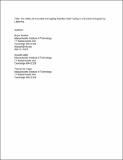Fire Safety of Grounded Corrugating Stainless Steel Tubing in a Structure Energized by Lightning
Author(s)
Galler, Donald; Eagar, Thomas W.; Haslam, Bryan Todd
Download10694_2015_557_ReferencePDF.pdf (67.23Mb)
OPEN_ACCESS_POLICY
Open Access Policy
Creative Commons Attribution-Noncommercial-Share Alike
Terms of use
Metadata
Show full item recordAbstract
Corrugated stainless steel tubing (CSST) has been used for more than 20 years as a replacement for conventional black iron gas piping. CSST has a thinner tubing wall and is susceptible to damage from lightning activity when discharges enter a structure, potentially resulting in perforation of the CSST wall and fire ignition. Grounding has been promoted by CSST manufacturers as a solution to this problem. We use modeling and simulation of voltage potentials and arc currents to evaluate the effects of grounding on the voltage potential across CSST, which can result in arc initiation, and charge through the arc, which can result in melting and perforation of the CSST wall. Our results show multiple scenarios where a 10 kA 10 × 350 s current waveform with 1 Ω grounding of the CSST still results in voltages greater than the arc initiation threshold of 25 kV and charge through the arc greater than 1.2 C, the perforation threshold we measured. For the case where lightning enters the structure through an outdoor light fixture or chimney, the presence of a grounding wire increases the charge through the arc from 0.13 C to 2.22 C. These results indicate that good grounding of CSST will not necessarily prevent arc initiation nor perforation of the CSST wall by lightning. Good grounding may in fact exacerbate the problem of lightning damage to CSST depending on where lightning enters the building and the electrical parameters of the path to ground.
Date issued
2016-02Department
Massachusetts Institute of Technology. Department of Electrical Engineering and Computer Science; Massachusetts Institute of Technology. Department of Materials Science and EngineeringJournal
Fire Technology
Publisher
Springer US
Citation
Haslam, Bryan, Donald Galler, and Thomas W. Eagar. “Fire Safety of Grounded Corrugating Stainless Steel Tubing in a Structure Energized by Lightning.” Fire Technology 52.2 (2016): 581–606.
Version: Author's final manuscript
ISSN
0015-2684
1572-8099